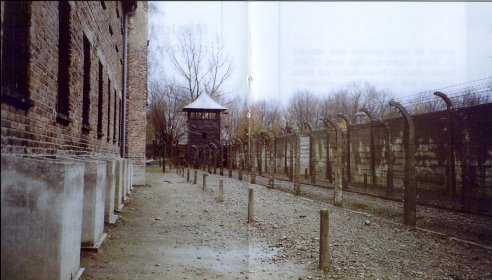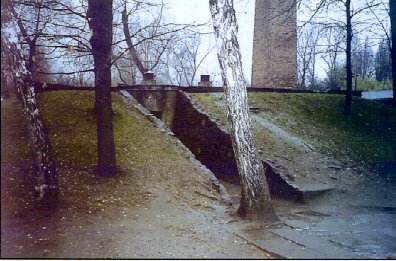
Pic above: The inner and outer perimeter walls with the sentry tower in the background. (Photo: Brian Abrahams)

Pic above: Entrance of a gas chamber the entrance on the roof was where
the poison pellets containing Zyklon-B were dropped through. (Photo: Brian Abrahams)
Auschwitz, together with its sister camps of Birkenau and Monowitz, was liberated by Russian troops on 27 January 1945.
Service of Remembrance
There is also a museum on site, documenting the history of Auschwitz and the other
local death-camps. Finally, the visitors moved on to light candles of Remembrance in the
Memorial Building and to recite the Hebrew ‘Prayer for the Dead’, led by Rabbi
Barry Marcus, the Minister at London’s Great Portland St. Synagogue.
When asked about his feelings, Brian told me: "It was just a totally
mind-blowing experience to learn that one human being could be so cruel to a fellow human.
Almost as bad, it seems that the world has learnt nothing - it is happening even now,
perhaps not on the same scale as Auschwitz. But the world has not yet learned its’
lesson…"
At midnight, as he slipped open the front door to his home, it was a tired
and reflective Brian who thought back to the days’ events, comparing the thin straw
mattresses of Auschwitz with the comfort of his own bed which he had left some 19 hours
earlier.
THANKS: My grateful thanks to Brian Abrahams for his patience over several interviews
and Brenda at the Osidge Library, Barnet, for her interest, allowing me access to private
and public books for research purposes.
© Alan Green 1999
Hope lives when people remember…Simon Wiesenthal
And so it was for Gypsies, Russian soldiers, dissidents or just about anyone else considered opponents of Hitler who would daily find themselves entombed and under threat of almost certain death.
Thoughtfully, Brian described the narrow wooden bunks that provided the accommodation in each hut stacked in tiers of three. An identical arrangement existed in the hospital block where patients often laid three to a bed. Invalidity for more than two weeks, invariably meant the gas chamber for those declared unfit for work through the
Collaborators
Brian showed me photos that he had taken of piles of shoes, briefcases (some monogrammed) and other personal effects. Particularly distressing was a table laid out with children’s clothes, the young owners probably murdered the day of their arrival at the camp. Collaborators, hoping to find favour with their captors and hence salvation, faired no better. They too were exterminated every few months, taking their secrets to the grave with them and therefore unable to testify later. The chief commandant of Auschwitz, Rudolf Hoss (not to be confused with Hess) rigorously enforced this ruthless regime.